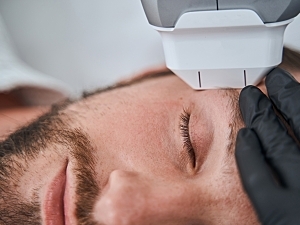With improvements in magnetic resonance imaging (MRI) technologies, including MR thermometry, it became possible to deliver ultrasonic energy to deep brain tissue through the skull without a craniotomy. MRI-guided focused ultrasound thalamotomy, approved in the U.S. in 2016, is now established to be effective in treating medication-refractory essential tremors.
As larger numbers of focused ultrasound thalamotomies are performed, neurosurgeons familiar with the technique are analyzing what variables contribute to optimal and sustained tremor reduction and how treatment-related adverse effects might be reduced.
David J. Segar, MD, senior resident in the Department of Neurosurgery at Brigham and Women’s Hospital, G. Rees Cosgrove, MD, director of epilepsy and functional neurosurgery at the Brigham, and colleagues have reported in Brain the largest single-surgeon series of focused ultrasound thalamotomy to date. They demonstrate tremor relief and adverse event rates consistent with previous reports and present new information about predictors of adverse events and lesion size.
Methods
The analysis included 123 patients who underwent focused ultrasound thalamotomy between March 2016 and June 2020 for medication-refractory essential tremor (n=118) or tremor-dominant Parkinson’s disease (n=5). The mean patient age was 75 (range, 55–93), and the mean disease duration was 29 years (range, 2–70).
The procedure was performed as neurosurgeons at the Brigham previously described in Neurosurgical Focus. All patients were assessed for tremor preoperatively, on day 1 after the procedure (“acute” time point), and at one month, three months, and one year as possible. Length of follow-up varied widely based on the patient’s city of residence and ability to return to the clinic.
Tremor Reduction
Tremor reduction data are presented only for patients with essential tremors. Intention tremor in the treated limb was reduced acutely by 90%, by 86% at three months, and by 80% at one year. Postural and rest tremors abated completely after surgery and remained well controlled during follow-up.
Acute tremor reduction was correlated only with increasing institutional experience with the procedure (q=0.19; P= 0.037).
Adverse Events
All adverse events (AE) were classified as mild. Gait imbalance was by far the most common acute AE noted (60% of patients), followed by paresthesia/numbness (26%), dysarthria (21%), orofacial symptoms (18%), dysmetria (13%), and motor weakness (9%). In 54% of cases, patients with any acute AE were likely to also experience imbalance.
All these AEs improved over time. At one year, the rates of gait imbalance, sensory deficits, and dysarthria were 15%, 17%, and 6%, respectively.
Predictors of Acute AEs
As a group, patients with any acute AE were more likely than patients without to have:
- Larger lesions (301 mm3 vs. 229 mm3; P=0.0184)
- More edema (P=0.047)
- More inferior lesions (P=0.0062)
- More lateral lesions (P=0.0027)
On postoperative MRI, 23 lesions had irregular T2 hyperintense “tails” extending obliquely away from the ellipsoid lesion, often into the internal capsule. 22 patients with such lesions (96%) experienced at least one AE.
Predictors of Lesion Size
In multivariate analysis, the most important predictors of increased lesion size were:
- Higher maximum power
- The rapid rise to high-power delivery
- The rapid rise to high tissue temperatures
Implications for Treatment Planning
Optimizing the location and size of the lesion is important to avoid encroachment on nuclei or tracts associated with AEs, such as the inferior and lateral regions as identified in this study. Tractography or direct visualization of the thalamic nuclei may be valuable.
Notably, targeting for focused ultrasound thalamotomy relies on different coordinates than those used for radiofrequency or deep brain stimulation. Surgeons at Massachusetts General Hospital now plan targets approximately 2 mm above the anterior commissure–posterior commissure plane to account for the inferior expansion of the lesion.
The principal shortcoming of focused ultrasound thalamotomy compared with deep brain stimulation continues to be the higher rates of AEs. Still, its minimally invasive nature allows treatment of selected patients who are otherwise poor candidates for awake surgery or general anesthesia. Increased experience with the procedure, patient-specific lesion targeting and improvements in lesion prediction may improve the AE profile.
